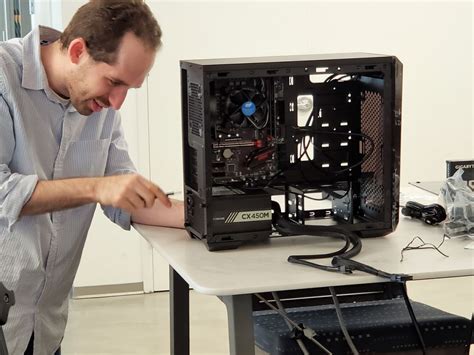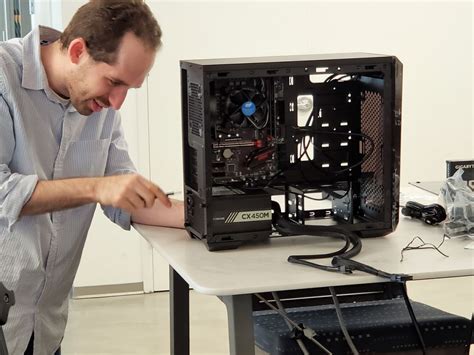

Learn how to build a computer from scratch with our step-by-step guide. Choose your components, assemble, and enjoy the satisfaction of DIY!
Building a computer may seem like a daunting task, but with the right tools and knowledge, it can be a rewarding and cost-effective way to customize your computing experience. Whether you’re a hardcore gamer looking to optimize your system’s performance or a professional in need of specialized hardware, building a computer gives you the flexibility and control to create the perfect machine for your needs. But where do you start? How do you ensure compatibility between components? And what are the latest trends and technologies in the ever-evolving world of computer hardware? Get ready to embark on a journey of discovery as we guide you through the exciting process of building your own PC.
Daftar Isi
Building Your Own Computer: A Step-by-Step Guide
Introduction
Building your own computer can seem like a daunting task, but with the right guidance and tools, it can be a rewarding experience. Not only will you save money, but you’ll also have a better understanding of how your computer works and the ability to customize it to your needs. In this article, we’ll guide you through the process of building your own computer from start to finish.
Gather Your Components
The first step in building a computer is to gather all the necessary components. This includes the motherboard, CPU, RAM, hard drive, power supply, case, and any additional components such as a graphics card or sound card. It’s important to research and select components that are compatible with each other and meet your needs and budget.
Prepare Your Work Space
Before beginning the assembly process, it’s important to prepare your work space. Choose a clean, well-lit area with plenty of room to maneuver. Use an anti-static mat and wrist strap to prevent damage to sensitive components. Lay out all your components and tools so that they’re easily accessible.
Install the CPU and RAM
The next step is to install the CPU and RAM onto the motherboard. Carefully align the CPU with the socket and secure it in place. Then, insert the RAM into the appropriate slots, making sure to apply even pressure until it clicks into place.
Install the Motherboard and Power Supply
Once the CPU and RAM are installed, it’s time to attach the motherboard to the case. Align the motherboard with the standoffs and screw it into place. Next, install the power supply, making sure to connect all necessary cables.
Install the Hard Drive
With the motherboard and power supply in place, it’s time to install the hard drive. Most cases have dedicated bays for hard drives, so simply slide the drive into place and secure it with screws.
Install Additional Components
If you’ve opted to include additional components such as a graphics card or sound card, now is the time to install them. Simply align the card with the appropriate slot and secure it in place.
Connect Cables and Power On
With all components installed, it’s time to connect the necessary cables and power on the computer. Connect the monitor, keyboard, mouse, and any other peripherals. Then, press the power button to turn on the computer.
Install Operating System and Drivers
Once the computer has powered on, it’s time to install the operating system and drivers. Follow the prompts to install the operating system of your choice and then install the necessary drivers for each component.
Test and Troubleshoot
After installing the operating system and drivers, it’s important to test the computer and troubleshoot any issues. Check that all components are working properly and that the computer is running smoothly. If any issues arise, consult online forums or seek professional help.
Conclusion
Building your own computer can be a fun and rewarding experience. By following these steps and taking your time, you can create a custom computer tailored to your needs and budget. Remember to research and select components carefully, prepare your work space, and take precautions to prevent damage to sensitive components. Happy building!Building your own computer can be an exciting and rewarding experience, but it requires careful planning and attention to detail. To get started, create a plan for your build based on your needs and budget. Consider the components you will need, including the motherboard, processor, RAM, hard drive, and optical drive(s). When choosing components, factor in cost, performance, and compatibility with your motherboard. Once you have your components, follow the manufacturer’s instructions to assemble your motherboard, install your power supply and case fans, and connect your cables and wires. Then, install your operating system and drivers, and test and troubleshoot any issues that arise. Finally, customize your computer with the programs and settings that suit your needs. With this step-by-step guide, you’ll be on your way to building your very own custom computer!
Building a computer is an exciting and rewarding experience for tech enthusiasts. It allows you to customize your system to fit your specific needs and preferences. However, it also comes with its own set of pros and cons.
Pros:
- Customization: Building your own computer gives you complete control over every component, allowing you to create a system that meets your specific needs and budget.
- Cost-effective: By selecting individual components, you can often save money compared to buying a pre-built system with similar specifications.
- Upgradeability: As technology advances, you can easily upgrade individual components in your system to keep it up-to-date without having to replace the entire system.
- Learning Experience: Building a computer provides valuable knowledge about how the components work together, which can be useful for troubleshooting and future upgrades.
Cons:
- Time-consuming: Building a computer can be a time-consuming process, especially if you are doing it for the first time. You need to research each component carefully and ensure compatibility, which can take up a lot of time.
- No Warranty: When building your own computer, you are responsible for each component’s warranty, which can make repairs or replacements more difficult and costly if something goes wrong.
- No Support: If you purchase a pre-built system, you have access to technical support and customer service. However, when building your own computer, you don’t have any support, and you’re responsible for troubleshooting and fixing issues on your own.
- Higher risk of damage: When building your own computer, there’s a higher risk of damaging components, especially if you have never done it before. This can lead to additional costs and delays in completing the build.
Overall, building a computer has its advantages and disadvantages. It’s essential to consider your budget, time, and technical knowledge before deciding whether to build a computer or buy a pre-built system.
As technology continues to evolve, more and more people are opting to build their own computers rather than buying pre-built ones. While this may seem like a daunting task for those who are not tech-savvy, building your own computer can be a fun and rewarding experience. In this article, we will provide you with some tips on how to build your own computer without any prior knowledge or experience.
The first step in building your own computer is to research the components that you will need. This includes the motherboard, CPU, RAM, graphics card, power supply, and storage. There are plenty of online resources available that can assist you in selecting the right components for your needs and budget. Once you have selected all of your components, it is important to ensure that they are all compatible with one another. This can be done by consulting the specifications of each component, or by using a compatibility checker tool.
Once you have all of your components, it is time to assemble your computer. This can be done by following step-by-step guides that are readily available online, or by watching video tutorials. Make sure to take your time during the assembly process, and double-check that everything is connected correctly before powering on your computer for the first time. After your computer is assembled, you will need to install an operating system and any necessary drivers before you can start using it.
In conclusion, building your own computer can be a fun and rewarding experience, even if you have no prior knowledge or experience. By doing your research, selecting compatible components, and following step-by-step guides, you can successfully build your own computer without any issues. So why not give it a try? Who knows, you might just surprise yourself with what you can accomplish!
Video build a computer
Visit VideoAs a journalist, I have noticed that many people are interested in building their own computer. Here are some of the most commonly asked questions about building a computer, along with the answers:
1. Why should I build my own computer instead of buying one?
Building your own computer allows you to customize it to your exact specifications. You can choose the components you want and make sure they are all compatible with each other. It can also be a fun and rewarding experience.
2. What components do I need to build a computer?
You will need a motherboard, CPU (Central Processing Unit), RAM (Random Access Memory), hard drive or solid-state drive, power supply unit, and a case to house everything in. You may also want a graphics card if you plan on using your computer for gaming or other graphic-intensive tasks.
3. How much does it cost to build a computer?
The cost of building a computer can vary depending on the components you choose. Generally, you can expect to spend anywhere from $500 to $2000 or more on a custom-built computer.
4. Do I need any special tools to build a computer?
You will need a screwdriver and possibly pliers to assemble the components. It’s also a good idea to have an anti-static wristband to prevent damage to the components.
5. Is it difficult to build a computer?
Building a computer requires some technical knowledge and patience, but it is not overly difficult. There are plenty of guides and tutorials available online to help you through the process.
6. Can I upgrade my computer after I build it?
Yes, one of the benefits of building your own computer is that it is easily upgradeable. You can swap out components as needed to keep your computer up-to-date and running smoothly.
Overall, building a computer can be a fun and rewarding experience for those who are up to the challenge. With the right components and a little bit of know-how, you can customize your computer to meet your specific needs and preferences.






